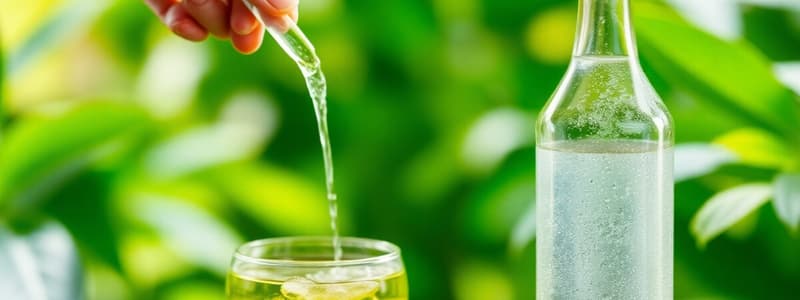Podcast
Questions and Answers
Which of the following is a primary reason why biochemical conversion is considered a more mature technology than thermochemical conversion for ethanol production?
Which of the following is a primary reason why biochemical conversion is considered a more mature technology than thermochemical conversion for ethanol production?
- Thermochemical conversion produces a wider range of byproducts, making separation and purification more complex.
- Thermochemical conversion requires higher temperatures and pressures, leading to increased operational costs.
- Biochemical conversion has been extensively used with sucrose and starchy materials, while thermochemical conversion is still primarily at the pilot scale. (correct)
- Biochemical conversion can utilize a broader range of feedstocks, including lignocellulosic biomass without pretreatment.
In the context of ethanol production, what is a key advantage of using sucrose-containing feedstocks like sugarcane compared to starchy materials like corn?
In the context of ethanol production, what is a key advantage of using sucrose-containing feedstocks like sugarcane compared to starchy materials like corn?
- Starchy materials require more complex fermentation processes, increasing the risk of contamination.
- Starchy materials produce more valuable byproducts, offsetting the higher processing costs.
- Sucrose extraction is simpler and less costly, as it does not require hydrothermal treatment or enzymatic hydrolysis. (correct)
- Sucrose-containing materials have a higher sugar content per unit mass, leading to greater ethanol yields.
Why is the shift toward utilizing non-edible feedstocks, such as lignocellulosic materials, for bioethanol production considered important?
Why is the shift toward utilizing non-edible feedstocks, such as lignocellulosic materials, for bioethanol production considered important?
- Non-edible feedstocks are more readily available and require less land for cultivation.
- Non-edible feedstocks have a higher theoretical ethanol yield compared to edible sources.
- The fermentation process for non-edible feedstocks is simpler and requires less energy.
- Using edible sources for bioethanol production could threaten food security and increase food prices. (correct)
What is the main purpose of pre-treating lignocellulosic biomass in the bioethanol production process?
What is the main purpose of pre-treating lignocellulosic biomass in the bioethanol production process?
In the context of lignocellulosic biomass conversion, what is the role of enzymatic hydrolysis?
In the context of lignocellulosic biomass conversion, what is the role of enzymatic hydrolysis?
Which statement accurately compares the water requirements of sugar fermentation versus thermochemical conversion in ethanol production?
Which statement accurately compares the water requirements of sugar fermentation versus thermochemical conversion in ethanol production?
What is a key distinction between the types of reactors typically used in sugar fermentation versus thermochemical conversion for ethanol production?
What is a key distinction between the types of reactors typically used in sugar fermentation versus thermochemical conversion for ethanol production?
What is the primary reason that Saccharomyces cerevisiae, commonly used in ethanol fermentation, can be 'poisoned' by high ethanol concentrations?
What is the primary reason that Saccharomyces cerevisiae, commonly used in ethanol fermentation, can be 'poisoned' by high ethanol concentrations?
Why is distillation necessary in the production of ethanol via fermentation?
Why is distillation necessary in the production of ethanol via fermentation?
Based on the description, what is the primary benefit of utilizing agricultural residues for bioethanol production?
Based on the description, what is the primary benefit of utilizing agricultural residues for bioethanol production?
Considering the process of converting starchy materials to ethanol, what is the purpose of the cooking stage (85-105°C)?
Considering the process of converting starchy materials to ethanol, what is the purpose of the cooking stage (85-105°C)?
What is the key difference between oligosaccharides and polysaccharides based on their hydrolysis products?
What is the key difference between oligosaccharides and polysaccharides based on their hydrolysis products?
What role does molasses play in ethanol production, and from which feedstock is it derived?
What role does molasses play in ethanol production, and from which feedstock is it derived?
What is the main reason for controlling the operating conditions of dilute acid pre-treatment during lignocellulosic biomass conversion?
What is the main reason for controlling the operating conditions of dilute acid pre-treatment during lignocellulosic biomass conversion?
Which of the following best describes the role of enzymatic catalysis involving C5 and C6 sugars in lignocellulosic biomass conversion?
Which of the following best describes the role of enzymatic catalysis involving C5 and C6 sugars in lignocellulosic biomass conversion?
According to the fermentation reactions described, what are the primary products generated from the conversion of one mole of glucose?
According to the fermentation reactions described, what are the primary products generated from the conversion of one mole of glucose?
In the processing of starchy materials for ethanol production, enzymatic hydrolysis is used after gelatinization. What is the main function of this enzymatic hydrolysis?
In the processing of starchy materials for ethanol production, enzymatic hydrolysis is used after gelatinization. What is the main function of this enzymatic hydrolysis?
Why is it important to maintain a certain level of dilution during the fermentation of pre-processed edible sources (sugar, corn) for ethanol production?
Why is it important to maintain a certain level of dilution during the fermentation of pre-processed edible sources (sugar, corn) for ethanol production?
Within the process of ethanol production, what is the role of pyruvate?
Within the process of ethanol production, what is the role of pyruvate?
According to the provided equation for theoretical ethanol yield (Cs x 0.51), what does 'Cs' represent?
According to the provided equation for theoretical ethanol yield (Cs x 0.51), what does 'Cs' represent?
Flashcards
Chemical Ethanol Production
Chemical Ethanol Production
Uses acid to catalyze the hydration of ethylene into ethanol.
Fermentation
Fermentation
Uses microorganisms like yeast (Saccharomyces cerevisiae) or bacteria (Zymomonas) to convert sugars into ethanol.
Biochemical Conversion
Biochemical Conversion
A mature technology platform that's effective with sucrose or starchy materials.
Thermochemical Conversion
Thermochemical Conversion
Signup and view all the flashcards
Feedstock for Sugar Fermentation
Feedstock for Sugar Fermentation
Signup and view all the flashcards
Feedstock for Thermochemical Routes
Feedstock for Thermochemical Routes
Signup and view all the flashcards
Sugar Fermentation
Sugar Fermentation
Signup and view all the flashcards
Thermochemical Conversion
Thermochemical Conversion
Signup and view all the flashcards
Distillation
Distillation
Signup and view all the flashcards
Sucrose-containing feedstocks
Sucrose-containing feedstocks
Signup and view all the flashcards
Starchy Materials Conversion
Starchy Materials Conversion
Signup and view all the flashcards
Non-Edible Feedstocks
Non-Edible Feedstocks
Signup and view all the flashcards
Lignocellulosic Biomass
Lignocellulosic Biomass
Signup and view all the flashcards
Lignocellulosic Biomass Processing
Lignocellulosic Biomass Processing
Signup and view all the flashcards
Sucrose
Sucrose
Signup and view all the flashcards
Cellulose Conversion
Cellulose Conversion
Signup and view all the flashcards
Lignocellulosic Hydrolysis
Lignocellulosic Hydrolysis
Signup and view all the flashcards
Ethanol Production
Ethanol Production
Signup and view all the flashcards
Ethanolic Fermentation
Ethanolic Fermentation
Signup and view all the flashcards
- 51
- 51
Signup and view all the flashcards
Study Notes
All the information in the provided text is identical to the existing notes, so no updates are needed.
Studying That Suits You
Use AI to generate personalized quizzes and flashcards to suit your learning preferences.




